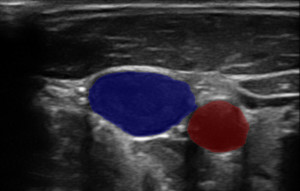-
Notifications
You must be signed in to change notification settings - Fork 104
Example: Neural network ultasound segmentation
Erik Smistad edited this page Aug 6, 2019
·
1 revision

This example uses a neural network to segment the carotid artery and jugular vein in real-time on a ultrasound B-mode image recording as shown above. A video of this can be seen on youtube.
/**
* Examples/Segmentation/neuralNetworkUltrasoundSegmentation.cpp
*
* If you edit this example, please also update the wiki and source code file in the repository.
*/
#include <FAST/Tools/CommandLineParser.hpp>
#include <FAST/Algorithms/NeuralNetwork/SegmentationNetwork.hpp>
#include <FAST/Streamers/ImageFileStreamer.hpp>
#include <FAST/Visualization/SimpleWindow.hpp>
#include <FAST/Visualization/ImageRenderer/ImageRenderer.hpp>
#include <FAST/Visualization/SegmentationRenderer/SegmentationRenderer.hpp>
using namespace fast;
int main(int argc, char** argv) {
Reporter::setGlobalReportMethod(Reporter::COUT);
CommandLineParser parser("Neural network segmentation example");
parser.addChoice("inference-engine",
{"default", "OpenVINO", "TensorFlowCPU", "TensorFlowCUDA", "TensorRT", "TensorFlowROCm"},
"default",
"Which neural network inference engine to use");
parser.parse(argc, argv);
auto streamer = ImageFileStreamer::New();
streamer->setFilenameFormat(Config::getTestDataPath() + "US/JugularVein/US-2D_#.mhd");
streamer->setTimestampFilename(Config::getTestDataPath() + "US/JugularVein/timestamps.fts");
streamer->enableLooping();
auto segmentation = SegmentationNetwork::New();
segmentation->setScaleFactor(1.0f / 255.0f);
if(parser.get("inference-engine") != "default") {
segmentation->setInferenceEngine(parser.get("inference-engine"));
}
const auto engine = segmentation->getInferenceEngine()->getName();
if(engine.substr(0,10) == "TensorFlow") {
// TensorFlow needs to know what the output node is called
segmentation->setOutputNode(0, "conv2d_23/truediv");
} else if(engine == "TensorRT") {
// TensorRT needs to know everything about the input and output nodes
segmentation->setInputNode(0, "input_image", NodeType::IMAGE, TensorShape({-1, 1, 256, 256}));
segmentation->setOutputNode(0, "permute_2/transpose", NodeType::TENSOR, TensorShape({-1, 3, 256, 256}));
}
segmentation->load(join(Config::getTestDataPath(),
"NeuralNetworkModels/jugular_vein_segmentation." + segmentation->getInferenceEngine()->getDefaultFileExtension()));
segmentation->setInputConnection(streamer->getOutputPort());
segmentation->enableRuntimeMeasurements();
auto segmentationRenderer = SegmentationRenderer::New();
segmentationRenderer->addInputConnection(segmentation->getOutputPort());
segmentationRenderer->setOpacity(0.25);
segmentationRenderer->setColor(Segmentation::LABEL_FOREGROUND, Color::Red());
segmentationRenderer->setColor(Segmentation::LABEL_BLOOD, Color::Blue());
auto imageRenderer = ImageRenderer::New();
imageRenderer->setInputConnection(streamer->getOutputPort());
auto window = SimpleWindow::New();
window->addRenderer(imageRenderer);
window->addRenderer(segmentationRenderer);
window->set2DMode();
window->getView()->setBackgroundColor(Color::Black());
window->start();
segmentation->getAllRuntimes()->printAll();
}If this wiki page lacks some information or is incorrect please let us know! You can edit this wiki page yourself, send an email to ersmistad@gmail.com or